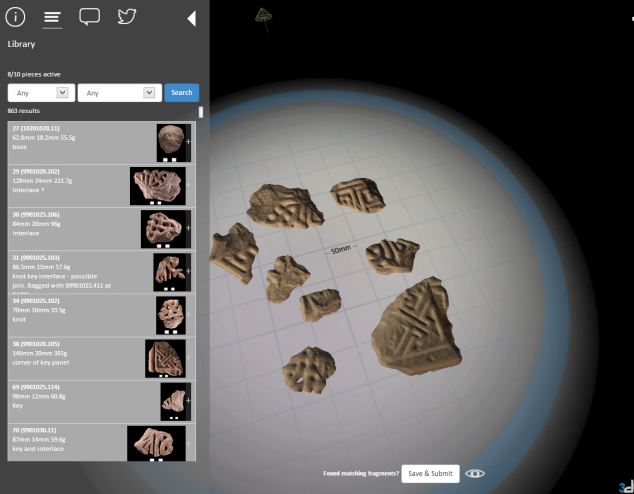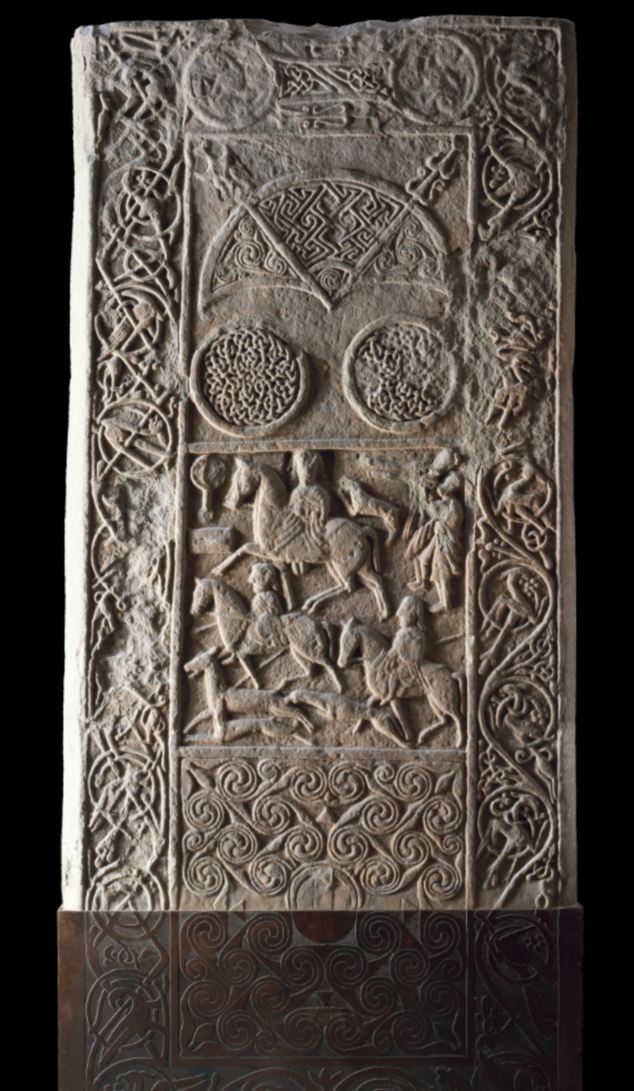Scotland's national museum is recruiting online gamers to help piece together 3,000 fragments of the Hilton of Cadboll Stone.
The stone was carved around 800AD in Inverness-shire which was then the heartland of the Picts. The top part of it was rediscovered in 1811, with the lower part, and several thousand carved fragments, being rediscovered in 2001.
The Picts had recently been converted to Christianity and it is thought that the main figure on the Hilton of Cadboll Stone is one of Scotland's earliest depictions of Jesus.
National Museums Scotland, in Edinburgh, wants gamers to help solve the mystery of the stone because they are thought to be better at manipulating on-screen objects and their skills could help experts interpret the stone’s elaborate symbols and carvings.
Can YOU solve this 1,200-year-old puzzle? Archaeologists ask online gamers to help piece together 3,000 pieces of stone cross
Recent excavations found scattered fragments of the cross at Easter Ross
Fragments were transported to hospital and put through a CT scanner
Digitised fragments are now part of a game that anyone can access online
Project is hoped to help experts interpret stone's elaborate carvings
By Ellie Zolfagharifard9 October 2013
Daily Mail

The Hilton of Cadboll Stone was rediscovered in 1811 on the Tarbat Peninsula, Easter Ross in Inverness-shire (Scottish Gaelic: Siorrachd Inbhir Nis)
Scotland’s national museum is recruiting online gamers to help piece together 3,000 fragments of the Hilton of Cadboll Stone.
The project will see gaming fans use a unique 3D programme to help unlock the mystery of the Pictish stone which was carved around 800AD in Inverness-shire.
Gamers are thought to be better at manipulating on-screen objects and their skills could help experts interpret the stone’s elaborate symbols and carvings.

Peebles-based Relicarte has developed a platform for online gamers to see if they can fit the stone fragments together
The stone was found in Easter Ross in Scotland’s Northern highlands, which was then a heartland of the Picts over 1,200 years ago.
Last year research on of the stone revealed that the main figure depicted was one of Scotland’s earliest depictions of Jesus.
The carvings were made onto local sandstone after the Picts converted to Christianity, in order to celebrate their new religion.
But over the centuries the stone, currently at the National Museums Scotland in Edinburgh, was knocked and broken a number of times.

The Hilton of Cadboll stone was carved around AD 800 in Inverness-shire, northern Scotland, then a heartland of the Picts. Carved from local sandstone, it displays sophisticated artistry and symbolism. It stands nearly 8 feet tall
At some point the stone was toppled, possibly in a storm in 1674, and the bottom portion lost.
In 1676 the original carving of the Christian cross was chipped off and replaced with an inscription commemorating a local man, Alexander Duff, and his three wives.
Excavations at its original site have found the stone’s base along with 3,000 scattered fragments of a cross, most of them small enough to fit in your hand.
Peebles-based Relicarte has developed a platform for online gamers to see if they can fit these fragments together.
The fragments were transported to Borders General Hospital and put through a CT scanner. The digitised fragments were then put into a computer programme.
From Friday 25th of October, anyone can go online and interact with the 3D models in real-time.
Mhairi Maxwell, a Glenmorangie Research Officer, said: ‘This 300-year old mystery is a jigsaw much larger than one person.
‘If we can come together to re-fit the pieces it will be a huge step forward in our understanding.’
The fragments will be displayed at an exhibition ‘Creative Spirit: Revealing Early Medieval Scotland which starts at the museum on 25 October.
THE HILTON OF CADBOLL STONE
The Hilton of Cadboll stone was carved around AD 800 in Inverness-shire, north-east Scotland, then a heartland of the Picts.
Carved from local sandstone, it displays sophisticated artistry and symbolism.
At some point the stone was toppled and broken, possibly in a storm in 1674.
Sometime before 1676 the original carving of the Christian cross was chipped off and replaced with an inscription commemorating a local man, Alexander Duff and his three wives.
300-900 AD, Early Medieval, is a formative period for Scotland as a multi-cultural nation, marking the arrival and adoption of Christianity, and the establishment of new Kingdoms.
Sculptured stones were created to celebrate these new ideas and beliefs.
Read more: Can YOU solve 1,200-year-old puzzle? Archaeologists ask online gamers to help | Mail Online
Follow us: @MailOnline on Twitter | DailyMail on Facebook
The stone was carved around 800AD in Inverness-shire which was then the heartland of the Picts. The top part of it was rediscovered in 1811, with the lower part, and several thousand carved fragments, being rediscovered in 2001.
The Picts had recently been converted to Christianity and it is thought that the main figure on the Hilton of Cadboll Stone is one of Scotland's earliest depictions of Jesus.
National Museums Scotland, in Edinburgh, wants gamers to help solve the mystery of the stone because they are thought to be better at manipulating on-screen objects and their skills could help experts interpret the stone’s elaborate symbols and carvings.
Can YOU solve this 1,200-year-old puzzle? Archaeologists ask online gamers to help piece together 3,000 pieces of stone cross
Recent excavations found scattered fragments of the cross at Easter Ross
Fragments were transported to hospital and put through a CT scanner
Digitised fragments are now part of a game that anyone can access online
Project is hoped to help experts interpret stone's elaborate carvings
By Ellie Zolfagharifard9 October 2013
Daily Mail

The Hilton of Cadboll Stone was rediscovered in 1811 on the Tarbat Peninsula, Easter Ross in Inverness-shire (Scottish Gaelic: Siorrachd Inbhir Nis)
Scotland’s national museum is recruiting online gamers to help piece together 3,000 fragments of the Hilton of Cadboll Stone.
The project will see gaming fans use a unique 3D programme to help unlock the mystery of the Pictish stone which was carved around 800AD in Inverness-shire.
Gamers are thought to be better at manipulating on-screen objects and their skills could help experts interpret the stone’s elaborate symbols and carvings.

Peebles-based Relicarte has developed a platform for online gamers to see if they can fit the stone fragments together
The stone was found in Easter Ross in Scotland’s Northern highlands, which was then a heartland of the Picts over 1,200 years ago.
Last year research on of the stone revealed that the main figure depicted was one of Scotland’s earliest depictions of Jesus.
The carvings were made onto local sandstone after the Picts converted to Christianity, in order to celebrate their new religion.
But over the centuries the stone, currently at the National Museums Scotland in Edinburgh, was knocked and broken a number of times.

The Hilton of Cadboll stone was carved around AD 800 in Inverness-shire, northern Scotland, then a heartland of the Picts. Carved from local sandstone, it displays sophisticated artistry and symbolism. It stands nearly 8 feet tall
At some point the stone was toppled, possibly in a storm in 1674, and the bottom portion lost.
In 1676 the original carving of the Christian cross was chipped off and replaced with an inscription commemorating a local man, Alexander Duff, and his three wives.
Excavations at its original site have found the stone’s base along with 3,000 scattered fragments of a cross, most of them small enough to fit in your hand.
Peebles-based Relicarte has developed a platform for online gamers to see if they can fit these fragments together.
The fragments were transported to Borders General Hospital and put through a CT scanner. The digitised fragments were then put into a computer programme.
From Friday 25th of October, anyone can go online and interact with the 3D models in real-time.
Mhairi Maxwell, a Glenmorangie Research Officer, said: ‘This 300-year old mystery is a jigsaw much larger than one person.
‘If we can come together to re-fit the pieces it will be a huge step forward in our understanding.’
The fragments will be displayed at an exhibition ‘Creative Spirit: Revealing Early Medieval Scotland which starts at the museum on 25 October.
THE HILTON OF CADBOLL STONE
The Hilton of Cadboll stone was carved around AD 800 in Inverness-shire, north-east Scotland, then a heartland of the Picts.
Carved from local sandstone, it displays sophisticated artistry and symbolism.
At some point the stone was toppled and broken, possibly in a storm in 1674.
Sometime before 1676 the original carving of the Christian cross was chipped off and replaced with an inscription commemorating a local man, Alexander Duff and his three wives.
300-900 AD, Early Medieval, is a formative period for Scotland as a multi-cultural nation, marking the arrival and adoption of Christianity, and the establishment of new Kingdoms.
Sculptured stones were created to celebrate these new ideas and beliefs.
Read more: Can YOU solve 1,200-year-old puzzle? Archaeologists ask online gamers to help | Mail Online
Follow us: @MailOnline on Twitter | DailyMail on Facebook
Last edited: